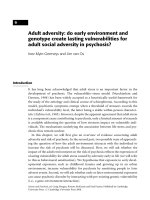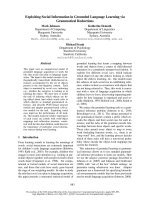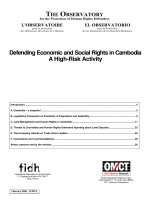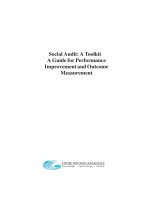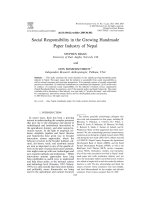Social audit in MGNREGS
Bạn đang xem bản rút gọn của tài liệu. Xem và tải ngay bản đầy đủ của tài liệu tại đây (3.43 MB, 46 trang )
Social Audit in MGNREGS
What is social audit
• Can be interpreted in many ways
• Assessment of how well a company has discharged its
social obligations
• In development programmes, social audit is a process by
which the people, the final beneficiaries of any scheme,
programme, policy or law, are empowered to audit such
schemes, programmes, policies and laws.
• A social audit is an ongoing process by which the potential
beneficiaries and other stakeholders of an activity or
project are involved from the planning to the monitoring
and evaluation of that activity or project.
• However, ‘social audit’ can also be understood in a broader
sense, as a continuous process of public vigilance.
Meaning of Social Audit
Social Audit is the process in which, details of the resource,
both financial and non-financial, used by public agencies
for development initiatives are shared with the people, often
through a public platform. Social Audits allow people to
enforce accountability and transparency, providing the
ultimate users an opportunity to scrutinize development
initiatives.
(Vision Foundation)
Meaning of Social Audit
A social audit is a process in which the people work with
the government to monitor and evaluate the planning and
implementation of a scheme or programme, or indeed a
policy or law. The social audit process is critically
dependent on the demystification and wide dissemination
of all relevant information (Definition of MKSS).
Types of Audits
• Government or Institutional Audits
( External and Internal)- Financial audits, Performance
Audits
• Public Audits- Peoples audit
• social audit
• Government audit –
• usually by professional auditors without
significant involvement of affected people.
• Assesses primarily procedural integrity and outputs,
• Little ability to get public perceptions or verify
outcome
People’s audits -
conducted by the people, sometimes with assistance from
movements and NGOs, with a standing invitation to the
government.
•Can get public perception, local knowledge and
public verification.
•Can assess outcomes and priorities.
However, low acceptance of findings among governments
Social audit -
conducted jointly by the government and the people, especially
by those people who are affected by, or are the intended
beneficiaries of, the scheme being audited.
Can bring on board the perceptions and knowledge of the
people,
Can look at outcomes and not just outputs,
Can involve the people in the task of verification,
Also, much greater acceptability by the government
The ideal scenario
Government audit remains the basic audit, but should be more
transparent and participatory.
Social audit conducted in addition for certain types of schemes
and activities, especially those involving huge expenditure and
distribution of benefits at grassroots.
Public audit selectively where the auditing process seems to have
failed
Social audit V/s Financial Audit
• FA= Was the money spent correctly
• SA= Did the spending make a difference
Why Social Audit
• One approach to strengthen good governance
through a process, which promotes transparency
and accountability
• To increase public participation
• To enable people exercise their rights
• For the effective implementation of the scheme
• To control irregularities
Origin of Social Audit
• To casual observer social auditing is a new
phenomenon.
• In reality, the concept of a social audit was formed
much earlier
• In 1940’s by Theodore Kreps from Stanford university
• Howard Bowen in 1953 and modern version in 1970
• Mostly called on companies to acknowledge their
responsibilities to citizens, how well discharged its
social
obligations
and
organisations social
performance.
Principles of Social Audit
• Transparency
• Participation
• Representative participation
• Consultation and Consent:
• Accountability
• Redressal:
Scope of Social Audit
SOCIAL AUDIT
Monitoring tool
Evaluation tool
Transparency & Accountability
tool
When should social audit be
conducted
• Planning stage
• Preparatory stage
• Implementation stage
• After the completion of work
Modes of carrying out Social Audit
• Campaign Mode
• By VMCs
• Separate Institution
• Third party like NGOs
Social Audit in MGNREGS
As per Guidelines
• Section 17 of the MGNREGA mandates conduct of SA
by Gram Sabha
• Employment Guarantee Day( Rozgar Diwas) – One day
in a week
• Social Audit Forums- Gram Sabhas- Twice a Year
• Use of RTI
Information to be collected
•
•
•
•
•
•
•
•
•
•
Plan of works
Decisions of Gram Sabha
List of Job card Holders
Administration and Funds grant
Technical approval and work order
Pay order, Muster Roll
Estimate copy
Measurements Book copy
Bank/Post office accounts opened, total payment sheet
Final Report
Mandatory Agenda
•
•
•
•
•
•
•
process of registration
Transparency in job cards preparation and updating
applications for work as per the norms
Transparency in the sanction of works
Transparency in the implementation of works
Wage payments
auditing of the records and accounts of each work
undertaken
• quality of work
• worksite facilities
• maintenance the works
Social Audit Process
• Verification of facts and figures is done by going door to
door
• Focused group discussions
• Night meetings with villagers
• Physical verification of works
• Conduct of Social Audit Public Meeting
How the SA is carried out- process
•
•
•
•
•
•
All the details of work/works to be collected
Concerned committee should come together
Plan must be formulated ( responsibilities sharing)
Application must be filed under RTI
Examining the information obtained
District and Block administration must be given
notice(date of social audit public meeting)
• Process- On the basis of information available labourers
must be met and figures on records must be verified with
actual facts on grounds
• Through FGDs and one to one interviews, the details of
implementation of MGNREGS must be found out
( identification of works, payment of wages, maintenance of
muster rolls, worksite facilities, promptness in showing the work
etc)
• If discrepancies are found thorough verification of facts and
written note of them duly signed by the labourers concerned
must be taken. This should be included in social audit report
• The information must be filled in social audit formats and must
be analyzed
• Public meeting should be arranged to discuss the findings of
Social audit
• Build Awareness among wage seekers on Rights and
Entitlements under MGNREGS
Elements of a Social Audit
1.
2.
3.
4.
Raising awareness of rights, entitlements and
obligations under a scheme.
Specifically, about the right to participate in a social
audit.
Ensuring that all forms and documents are user
friendly.
Ensuring all relevant information is accessible,
displayed and read out.
Elements of a Social Audit
5. Ensuring that the decision making process is
transparent, participatory and, as far as
possible, carried out in the presence of the
affected persons.
6. Ensuring that all decisions, and their
rationale, are made public as soon as they are
made.
7. Ensuring that measurements, certification
and inspection involves the affected people
on a random and rotational basis.
Elements of a Social Audit
8.
Ensuring that there are regular (six monthly) public
hearings (jan audit manch) where the scheme and the
process of social auditing is publicly analysed.
9. Ensuring that the findings of social audits are
immediately acted upon.
10. Also ensuring that these findings result in the
required systemic changes.

